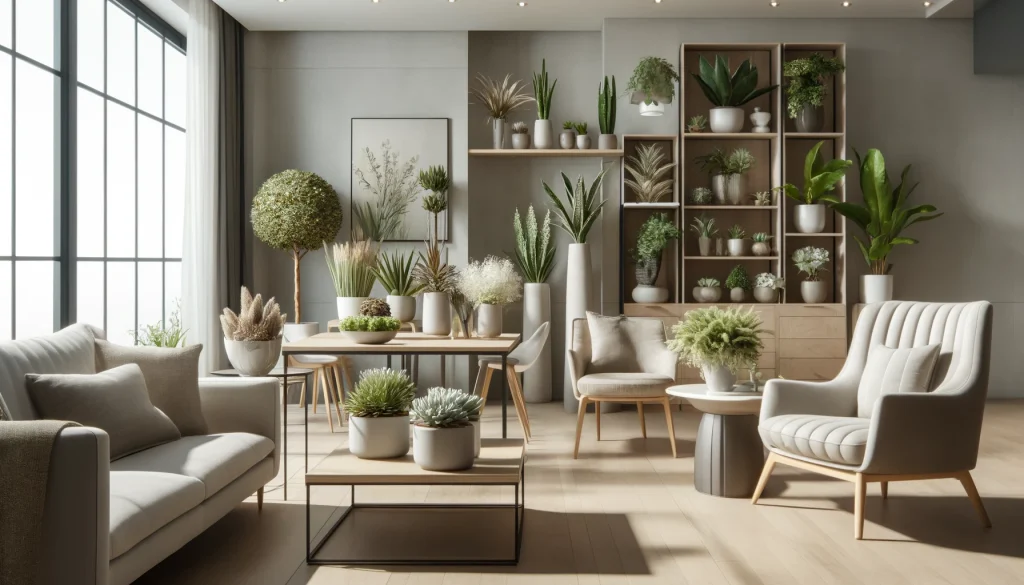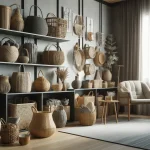Decorating a space can be a challenge, especially for those looking for low-maintenance, yet stylish options. Enter the world of artificial plants, a growing trend in home and office decor that offers a realistic and affordable way to add a touch of greenery to any environment.
Whether you’re looking to complement your home with a splash of color or want to transform your workspace into a more inviting area, the variety of faux plants and flowers available today can cater to every taste and need. Let’s explore the benefits and best practices of decorating with artificial greenery.
What are the benefits of artificial plants?
The allure of artificial plants lies in their effortless maintenance. Unlike real plants, they don’t require watering, sunlight, or pruning. They’re perfect for busy individuals and those without a green thumb. Additionally, faux plants remain vibrant and lively year-round, offering a consistent aesthetic appeal without seasonal changes.
For those with allergies, artificial plants present a clear advantage—they don’t produce pollen or spores, making them an excellent allergy-friendly decor option. Plus, pet owners can rejoice as many artificial plants are safe and non-toxic, eliminating the worry of pets ingesting harmful plants.
Moreover, artificial plants are incredibly versatile. They can be placed in areas with low light where real plants wouldn’t thrive, and they’re perfect for adding greenery to office settings, where regular plant care might be impractical.
How to choose the best artificial plants for your home
Selecting the right artificial plants involves considering the space’s design and the desired ambiance. To achieve a realistic look, opt for high-quality faux plants with detailed textures and natural-looking color gradients. Silk flowers and premium plastic plants can closely mimic the real thing.
Consider the scale of your space when choosing artificial plants. Larger rooms might benefit from a statement-making faux tree, while smaller spaces can be enhanced with delicate artificial flowers. Also, think about the plant’s container—it should match your interior design style and complement the plant’s aesthetics.
Low-light rooms, such as basements and bathrooms, are ideal for artificial plants. You can brighten these spaces with greenery that would otherwise struggle to survive.
When shopping, explore reputable retailers that specialize in realistic artificial plants. Places like Blooming Artificial are known for their high-quality offerings that provide durable and stylish decor solutions.
Here are some ideas:







Top tips for styling with artificial flowers
Styling with artificial flowers can breathe new life into a room. Start by considering the room’s color palette and choosing flowers that either complement or provide a striking contrast. Seasonal arrangements can also be a fun way to keep your decor fresh and in line with the time of year.
Mix different types and sizes of artificial flowers to create texture and depth. Using varying heights and shapes can result in a more natural and appealing display. Remember to dust your flowers regularly to maintain a fresh, vibrant look.
Get creative by incorporating artificial flowers into unexpected places like wall art, centerpieces, or even as part of a table setting. The beauty of faux flowers is that they can be manipulated without the risk of wilting, so let your creativity run wild.
Are artificial plants worth it?
When weighing the cost against benefits, artificial plants often come out on top. They are a one-time investment that can provide years of aesthetic pleasure without the ongoing costs of water, fertilizer, or replacement plants.
For businesses, artificial plants can be a smart choice. They require no care, saving on the cost of maintenance, and they can be used to create a welcoming atmosphere in lobbies, offices, and communal areas.
Additionally, the versatility and durability of artificial plants make them a practical choice for event planners and rental spaces where they can be reused multiple times for different setups.
How to maintain and clean your faux plants
Maintenance of artificial plants is minimal, but they do require occasional cleaning to look their best. Dust can be quickly removed with a feather duster, or for a deeper clean, use a damp cloth to wipe down leaves.
If your faux plants have intricate detailing, consider using a small paintbrush to reach into crevices. For a thorough clean, some artificial plants can be gently rinsed with water, though it’s important to check the manufacturer’s instructions first.
Avoid using harsh chemicals or abrasive cleaning tools as these can damage the plant’s surfaces. Regular light cleaning can prevent the need for more intense cleaning sessions, keeping your plants looking fresh year-round.
Transform your office with artificial greenery
Artificial plants can make a significant impact in office spaces, creating a more pleasant and inviting work environment. They can contribute to reducing stress and increasing productivity amongst employees.
Consider placing larger plants in communal areas for a communal touch of nature. Smaller desk plants can personalize workspaces without the worry of spills or care schedules.
For meeting rooms or areas where clients might visit, choose high-end artificial plants that make a statement and reflect the company’s attention to detail and aesthetics.
Frequently Asked Questions About Artificial Plants
Are artificial plants worth it?
Yes, artificial plants are worth it for many people. They offer enduring beauty without the maintenance required by living plants, making them a cost-effective and convenient option for both homes and businesses.
They are particularly beneficial for those with busy lifestyles, limited access to natural light, or those who travel frequently. The initial investment can be offset by the longevity and low care requirements of these plants.
How long do fake plants last?
Fake plants can last for many years with proper care. They are not subject to the same diseases or lifespan limitations as live plants, so they remain vibrant indefinitely. The durability of materials used in high-quality artificial plants can extend their life even further.
To ensure longevity, keep them out of direct sunlight to prevent colors from fading, and clean them regularly to maintain their appearance.
Why not to keep artificial plants at home?
While there are many benefits to artificial plants, some may prefer real plants for their natural beauty and the benefits of air purification. However, for those without the time or conditions to care for real plants, artificial ones can be a fantastic alternative.
Others may have concerns about the environmental impact of plastic plants. In such cases, it’s essential to source faux plants from companies that use sustainable practices and materials.
What is the best material for artificial plants?
The best material for artificial plants is typically high-grade plastics or silk. These materials can provide a realistic look and feel, as well as durability. Silk flowers have a reputation for their intricate details and natural drape.
When choosing artificial plants, look for materials that are UV resistant to prevent fading, especially if the plants will be placed in well-lit areas.
In conclusion, artificial plants can be a smart and stylish addition to any space. With the vast array of options available, it’s easy to find the perfect plant to fit your style and needs. They offer the beauty of nature without any of the hassle, making them an excellent choice for modern, low-maintenance decor.



